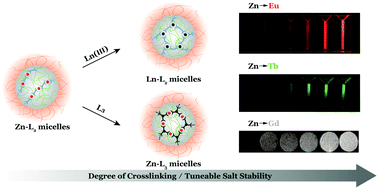Supramolecular crosslinks enable PIC micelles with tuneable salt stability and diverse properties†
Abstract
The stability of polyion complex (PIC) nanoparticles, like PIC micelles or PICsomes, in water is typically affected by added salt because salt screens the electrostatic driving force. This lack of salt stability seriously hampers numerous potential applications and a remedy is needed. Extending an earlier idea, we develop here a general strategy for preparing PIC micelles, with not only tuneable salt stability but also built-in functions. Using two different dipicolinic (DPA)-based ligands (a linear bis-ligand and a branched tris-ligand), as well as various metal ions we obtain anionic coordination polymers that subsequently co-assemble with a polycationic-neutral diblock copolymer to form PIC micelles. By a judicious choice of the metal ions and/or an appropriate mixture of the ligands we can create micellar cores with two types of reversible cross-links. In this way, we construct PIC micelles with not only tuneable and enhanced salt stability, but also tuned metal-derived properties, such as luminescence or magnetic relaxation. This non-covalent cross-link strategy, exclusively based on building block composition, is generally applicable with different metal ions and ligand combinations, and is therefore a robust approach for preparing stable and functional PIC micelles. Extension to other types of assemblies such as ‘PICsomes’ is possible, and therefore a range of applications becomes feasible.



 Please wait while we load your content...
Please wait while we load your content...